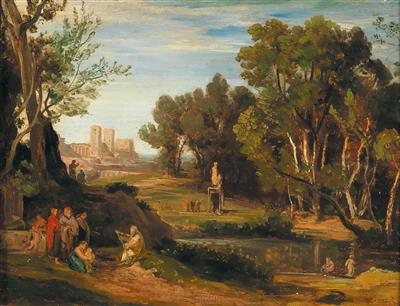Johann Wilhelm Schirmer

(Jülich 1807–1863 Karlsruhe)
Study for the invention of the arts by Cain’s progeny, on the reverse numerous labels as well as the inscription Gurlit, oil on board, 36.5 x 44 cm, framed behind glass, (Rei)
Provenance:
From the artist’s estate;
1918/1919 Ms von Zittel, Heidelberg;
1918/1919 Galerie Heinemann, Munich (no. 14020);
1919–1939 Collection of Carl (1882–1980) and Alice (1896–1984) Bach, Munich;
Acquired by the Österreichische Galerie Belvedere (inventory no. 3972) in 1944 through Galerie Wolfgang Gurlitt, Berlin;
17.3.2017 recommendation to return to the heirs of Carl and Alice Bach; 27.2.2018 restitution and deaccessioning.
Compare:
Johann Wilhelm Schirmer. Vom Rheinland in die Welt. Vol. 1 Catalogue, ed. by Marcell Perse, et al., Petersberg 2010, p. 533 nos 108–110.
Johann Wilhelm Schirmer was a German landscape painter of the Düsseldorf School. After training in Düsseldorf and travelling to the Netherlands and Northern France, he embarked on a journey to Italy in 1840. The oil sketches and drawings he executed during the aforementioned trips would subsequently serve him as his personal image reservoir, becoming the basis of his oil paintings.
Schirmer was especially fascinated by the colours and graphic features of different types of tree, and for this reason he completed a number of studies of this subject.
From about 1840 onwards, Schirmer devoted himself to painting idealised landscapes with religious figural staffage. He thus succeeded in combining classic landscape painting with the more highly regarded genre of history painting. Such synthesis allowed Schirmer to go beyond the “inferior” genre of landscape painting and establish himself as a more respectable artist. This change probably took place in connection with his appointment to the post of director of the Academy of Fine Arts in Karlsruhe.
Schirmer achieved great success with a cycle of 26 large-format charcoal drawings featuring old-testament themes. These works were displayed in a travelling exhibition in varying German cities between 1855 and 1856. As a reaction to the positive reception of his charcoal drawings, Schirmer reproduced the same scenes as larger oil studies. The present lot was probably created in this context and can be therefore dated to 1856. Both the casual highlights on the tree trunks and the sketched figures are typical of the fluid, confident style that characterises Schirmer’s oil studies.
Esperta: Mag. Dimitra Reimüller
 Mag. Dimitra Reimüller
Mag. Dimitra Reimüller
+43-1-515 60-355
19c.paintings@dorotheum.at
24.10.2018 - 18:00
- Prezzo realizzato: **
-
EUR 15.000,-
- Stima:
-
EUR 8.000,- a EUR 12.000,-
Johann Wilhelm Schirmer
(Jülich 1807–1863 Karlsruhe)
Study for the invention of the arts by Cain’s progeny, on the reverse numerous labels as well as the inscription Gurlit, oil on board, 36.5 x 44 cm, framed behind glass, (Rei)
Provenance:
From the artist’s estate;
1918/1919 Ms von Zittel, Heidelberg;
1918/1919 Galerie Heinemann, Munich (no. 14020);
1919–1939 Collection of Carl (1882–1980) and Alice (1896–1984) Bach, Munich;
Acquired by the Österreichische Galerie Belvedere (inventory no. 3972) in 1944 through Galerie Wolfgang Gurlitt, Berlin;
17.3.2017 recommendation to return to the heirs of Carl and Alice Bach; 27.2.2018 restitution and deaccessioning.
Compare:
Johann Wilhelm Schirmer. Vom Rheinland in die Welt. Vol. 1 Catalogue, ed. by Marcell Perse, et al., Petersberg 2010, p. 533 nos 108–110.
Johann Wilhelm Schirmer was a German landscape painter of the Düsseldorf School. After training in Düsseldorf and travelling to the Netherlands and Northern France, he embarked on a journey to Italy in 1840. The oil sketches and drawings he executed during the aforementioned trips would subsequently serve him as his personal image reservoir, becoming the basis of his oil paintings.
Schirmer was especially fascinated by the colours and graphic features of different types of tree, and for this reason he completed a number of studies of this subject.
From about 1840 onwards, Schirmer devoted himself to painting idealised landscapes with religious figural staffage. He thus succeeded in combining classic landscape painting with the more highly regarded genre of history painting. Such synthesis allowed Schirmer to go beyond the “inferior” genre of landscape painting and establish himself as a more respectable artist. This change probably took place in connection with his appointment to the post of director of the Academy of Fine Arts in Karlsruhe.
Schirmer achieved great success with a cycle of 26 large-format charcoal drawings featuring old-testament themes. These works were displayed in a travelling exhibition in varying German cities between 1855 and 1856. As a reaction to the positive reception of his charcoal drawings, Schirmer reproduced the same scenes as larger oil studies. The present lot was probably created in this context and can be therefore dated to 1856. Both the casual highlights on the tree trunks and the sketched figures are typical of the fluid, confident style that characterises Schirmer’s oil studies.
Esperta: Mag. Dimitra Reimüller
 Mag. Dimitra Reimüller
Mag. Dimitra Reimüller
+43-1-515 60-355
19c.paintings@dorotheum.at
|
Hotline dell'acquirente
lun-ven: 10.00 - 17.00
kundendienst@dorotheum.at +43 1 515 60 200 |
| Asta: | Dipinti dell’Ottocento |
| Tipo d'asta: | Asta in sala |
| Data: | 24.10.2018 - 18:00 |
| Luogo dell'asta: | Wien | Palais Dorotheum |
| Esposizione: | 13.10. - 24.10.2018 |
** Prezzo d'acquisto comprensivo di tassa di vendita e IVA
Non è più possibile effettuare un ordine di acquisto su Internet. L'asta è in preparazione o è già stata eseguita.
